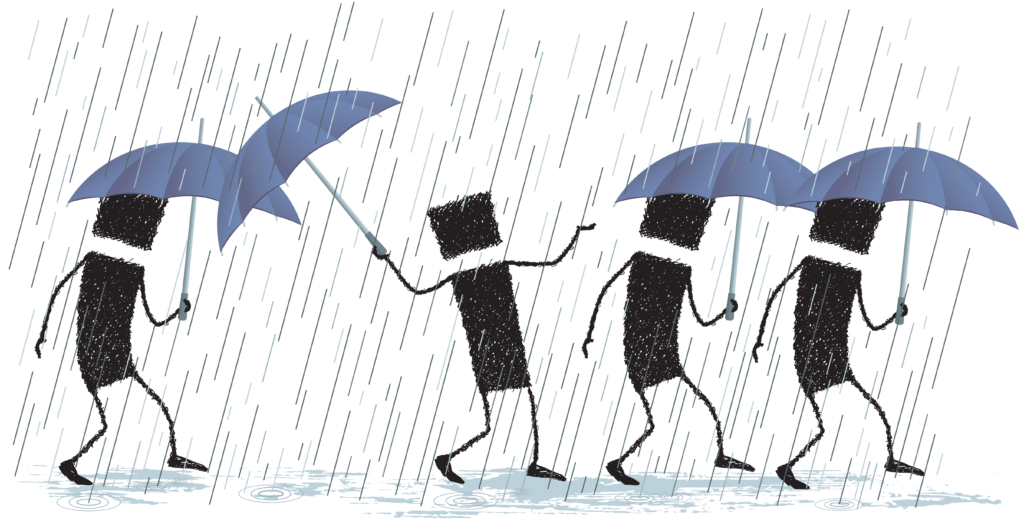
BY BETH PINYERD
OPINION —
I love living in central Alabama where we experience a lot of Spring rains. I remember sitting on my parents’ screened back porch and watching the rains come in. Living in south Alabama by the beautiful Mobile Bay for many years it was breathtaking to observe a wall of water coming in as rain.
Springtime rain is so refreshing and cool as it waters our beautiful earth, plants, flowers and us. This is a time you can nurture your child’s learning of rain by taking the time out and safely playing or singing in the rain. Not singing in lightning and thunder, but singing in the rain.
Every day when your little one walks out of the house they immediately experience the weather, whether it be sunny or rainy. One lesson I love to teach is following the travels of “Jimmy Raindrop.” Parents, grandparents, you can put your child’s name as the raindrop too like “Jane Raindrop” for girls, etc. Using this visible little guy or girl that I draw on the chalkboard or paper as a raindrop seems to simplify the learning of the water cycle for young children to grasp. They are fascinated by following Jimmy Raindrops’ travels from earth to sky.
Water has been around for a very long time, but the earth does have a limited amount of water. That water keeps going around and around in what is called the water cycle. The cycle is made up of a few parts that we have to put in simple terms for young children to understand. These simple explanations for families to us in explaining the water cycle are listed below:
- Evaporation is when the sun warms and heats up the water in rivers, lakes and oceans and turns it into vapor or steam. As I explain to my students, “Jimmy raindrop is swimming in the ocean, lakes, rivers and streams. The sun warms him up, then he floats in the sky. I wonder what will he see as he goes up in the sky?”
We know we sweat when we get red, hot and sticky from working and playing outdoors; but do plants sweat?
People sweat, but plants transpire, and this gives Jimmy Raindrop a little boost as he floats up with other raindrops in the sky. I tell my young students that Jimmy Raindrop has company.
An easy experiment to do at home on evaporation is to put water in a glass, keep it on a window sill, check it daily, record what you see and watch it go away. What happened to the water that disappeared? It evaporated. As an experiment, I put a wet streak on the board, and we go out of the room. When we return the wet streak has gone away. Where did it go? It evaporated. - Condensation is when the water vapor in the air changes back into water or liquid to form clouds. The air gets colder so Jimmy Raindrop and his friends experience cold surroundings as they change back from a vapor into water. You can show your young child this concept by pouring a cold glass of water or lemonade on a hot day and watch how the water forms on the outside of the glass or pitcher. Children love to use their fingers drawing happy faces and happy scenes on the outside of the glass or pitcher. Explain to the children that water did not actually leak through the glass but the water vapor turns back into liquid when it hits the cold glass. Interesting concept to learn. Keep in mind as you are using your Jimmy Raindrop pictures you are making him look like a raindrop, then water vapor, back to a raindrop. Children are absolutely fascinated that Jimmy Raindrop can take on many shapes.
- Precipitation occurs when so much water vapor has gone through the process of condensation that the air cannot hold it anymore. The clouds get so heavy and full that the water falls back to the earth in the form of rain or other forms of precipitation like hail, sleet or snow.
I like to review information about clouds with the readers who have young children or grandchildren, especially in the spring and summer months.
(a) Cirrus clouds: They look like long, feathery clouds. When we see a lot of cirrus clouds it often means bad weather is on the way.
(b) Cumulus clouds: These clouds remind us of cotton candy or big fluff wool. They are easily seen far up in the sky, and the sky is usually blue. It’s neat to observe how cumulus clouds build up for an afternoon shower. This encourages childrem to observe over a longer period of time as the clouds billow up during the day. These are the kinds of clouds too in which it is easy to use our imaginations and see different shapes and figures.
(c) Status clouds: These are usually dark, gloomy and heavy looking featureless clouds that are of low altitude. Fog is a stratus cloud in contact with the ground. - Collection is when the water (precipitation) falls back to Earth on the ground, lakes, rivers, streams, and oceans. It will soak into the soil and become ground water that nourishes our plants and animals or it may collect in the oceans, lakes or rivers — then the water cycle begin again.
Isn’t this a fascinating trip of water drops traveling from earth to sky in a continuous cycle. Enjoy these spring showers as a teaching lesson. Remember your young child is a rainbow of a promise as you take time to simply teach them about the beautiful world they live in. Parents, grandparents nurture their little minds and world with time, teaching and learning. Let’s join hand in hand and go run in the rain.
I want to wish all readers a very Happy Easter this coming Sunday.
Beth Pinyerd has taught many years in the early childhood classroom. She has a master’s degree in early childhood education.


